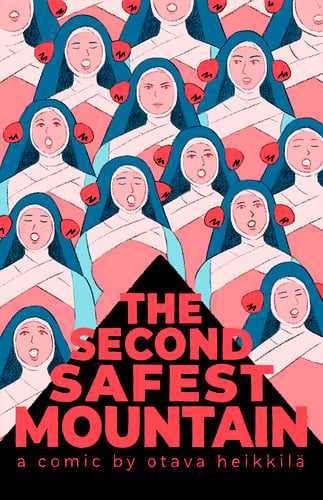The Indescribable Horror of “The Second Safest Mountain”
Exploring the stylized terror of Otava Heikkilä's "The Second Safest Mountain"

I’ve been thinking about horror a lot lately. Some of that comes from writing about the genre more and more; some of that comes from writing stories that draw more and more on horror. I think about how the idea of horror is very subjective as well — for me, the final revelations of (say) the film Longlegs were incredibly effective as a kind of moral horror; I also know some viewers for whom those same moments fell flat.
I’m not entirely sure what first led me to Otava Heikkilä’s The Second Safest Mountain. I’m pretty sure it was the recommendation of Ritesh Babu, whose reflections on the medium have pointed me to a host of great comics over the years. At the time, the book was only available digitally, but there’s been a print edition released since then. For me, it’s a near-perfect example of how a very specific sort of horror can be especially evocative.

The first thing you should know about The Second Safest Mountain is that its title is very literal. There’s a collection of buildings — call it a monastery or complex or village — situated at the top of a mountain. A group of women live there, largely clad in uniforms that evoke a nun’s garments. What’s also noticeable is that the women all wear long coverings over their hands, presumably to restrict their mobility. And, as the reader will soon learn, this is literally the second safest mountain one can live on.
That prompts the next logical question: safe from what? Turns out there’s a being known as Father that makes periodic visits to the mountaintop. There’s something dragonlike about Father: the combination of a torso, wings, and a tail will do that. But those wings recall a dragonfly more than anything else. There’s no head, and the tail has — shall we say — phallic components as well. And there’s also the matter of Father’s lack of skin, which calls to mind the nuckelavee, a skinless demon mentioned in the folk tales of the Orkney Islands.
The Second Safest Mountain has a mythic, allegorical quality to it: it’s set in an archetypal landscape that feels simultaneously alien and familiar. (The women’s penchant for cigarettes feels like a more modern flourish, for instance.) This could also be described as a literally patriarchal society; there’s mention at one moment of the society being measured in terms of “the span of what flew above us.” That sense of this being a story out of time is echoed by moments in the narration as well: “In our time, and in your time as well, the world was swallowed by an unfair darkness.”
Eventually, Heikkilä gradually focuses the reader’s attention on Aru, one of the mountain’s residents. Aru seeks another way of life; it’s suggested that they are possibly transgender, or at someone with a significantly different relationship to gender than the ulta-feminine presentation of many of the mountain’s residents. Aru winds up spending more and more time at the bottom of the mountain, where a group of outcasts are engaged in an endless process of digging.
This ersatz society also has a chilling relationship to Father. “It maims those it doesn’t claim as its own,” one character declares — and all of the people Aru meets there carry scars to some degree on their bodies. There’s certainly an element of metaphor here, but also, it’s just unsettling throughout, from the cultlike elements atop the mountain to the physical dangers situated below.
Both textually and visually, Heikkilä combines relatively straightforward storytelling with more elliptical elements. The figures are boldly drawn, and the images are clear — but there’s also a lot left implicit that rewards multiple readings. In the end, The Second Safest Mountain is about the terror of living in a brutal, controlling system and the fears that come with finding a way out. It’s a very specific kind of horror, but it’s no less effective for it.